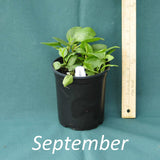It’s fall and I’m putting in new species this year, as well as filling in some existing plant species to add more of a stand of a few things.
I never updated when we put in the winterberry hollies in the newish bird haven garden area, which was created when we fenced in the furthest front corner of the front pasture. The winterberry hollies are now a year old in their new space.
The horses would often gather in that corner, hanging their heads over the fence, and because of the way the foliage grows there, I couldn’t see them from the porch and would stress that they may have gotten out. So by fencing the corner, we moved them back from that area and gained a new space where we could not only add native plantings, but put in landscaping rock to slow the stormwater stream that can get quite intense when we have a lot of rain. It’s been a space that is mostly barren of anything but the large deciduous trees there, and since it’s shady and also a periodic wet area, it gives me the chance to experiment with a shady site rain garden pollinator and wildlife friendly habitat.
The first thing we put in were the interior to the perimeter fence southern bayberries, in hopes that they will grow tall and offer some screening around that front corner. They’ll also offer food for birds and other wildlife and pollinator forage.
The second thing we put in were the winterberry hollies. These are also very good for pollinators and wildlife, and they offer the added benefit of bright red berries that persist in the middle of winter after the holly has lost its leaves. Who could resist having some built-in holiday decor in the front corner?
We have red berries forming already this fall, which means we have both male and female plants and hopefully as they mature we’ll get a lot of color and food for the birds.
More about the winterberry holly from the Missouri Botanical Garden’s website:
Common Name: winterberry

Type: Deciduous shrub
Family: Aquifoliaceae
Native Range: Eastern North America
Zone: 3 to 9
Height: 3.00 to 12.00 feet
Spread: 3.00 to 12.00 feet
Bloom Time: June to July
Bloom Description: Greenish-white
Sun: Full sun to part shade
Water: Medium to wet
Maintenance: Low
Suggested Use: Hedge, Rain Garden
Flower: Insignificant
Attracts: Birds
Fruit: Showy
Tolerate: Erosion, Clay Soil, Wet Soil, Air Pollution
Culture
Easily grown in average, acidic, medium to wet soils in full sun to part shade. Adaptable to both light and heavy soils, but prefers moist, acidic, organic loams. Good tolerance for poorly drained soils including wet boggy or swampy conditions (this species is native to swampy areas of Eastern North America). Winterberries are dioecious (separate male and female plants). Only fertilized female flowers will produce the attractive red berries that are the signature of the species. Generally one male winterberry will be sufficient for pollinating 6-10 female plants. Flowers appear on new growth. Prune to shape in early spring just before new growth appears.
Noteworthy Characteristics
Ilex verticillata, commonly called winterberry, is a deciduous holly that is native to eastern North America where it typically occurs in swamps, damp thickets, low woods and along ponds and streams. The form of this plant found in Missouri is Ilex verticillatavar. padifolia, which occurs in “shut-ins”, granite rocky stream beds and sandstone bluffs in only 4 counties in the southeastern part of the state (Steyermark). This is a slow-growing, deciduous shrub with an upright-rounded habit that typically grows 3-12’ tall. In the wild, it often suckers to form large thickets or colonies. Elliptic to obovate, toothed, dark green leaves (2-3” long). Fall color is usually negligible, but in some years leaves may turn attractive shades of maroon. Relatively inconspicuous greenish-white flowers appear in the leaf axils in late spring. Flowers, if properly pollinated, give way to a crop of bright red berries (1/4” diameter) in late summer to fall. Berries are quite showy and will persist throughout the winter (hence the common name) and often into early spring. Berries provide considerable impact and interest to the winter landscape.
Genus name comes from the Latin name Quercus ilex for holm oak in reference to the foliage similarities (holm oak and many of the shrubs in the genus Ilex have evergreen leaves).
Specific epithet from Latin means whorled in reference to the arrangement of sessile fruits in pseudo-whorls around the stems.
Common name comes form the quite showy berries that will persist throughout the winter and often into early spring.
Problems
No serious insect or disease problems. Occasional disease problems include leaf spots and powdery mildew. Plants do poorly in neutral to alkaline soils where they are susceptible to chlorosis (yellowing of leaves) and often die.
Uses
Year round interest, highlighted by the showy display of red berries in winter. Mass or group in shrub borders, foundations, native plant areas or bird gardens. Hedge. Excellent shrub for moist soils in low spots or along streams and ponds. Although an attractive shrub, the species is infrequently sold in commerce because of the many excellent cultivars which generally produce showier flowers and larger, more abundant fruit.


.jpg)





























